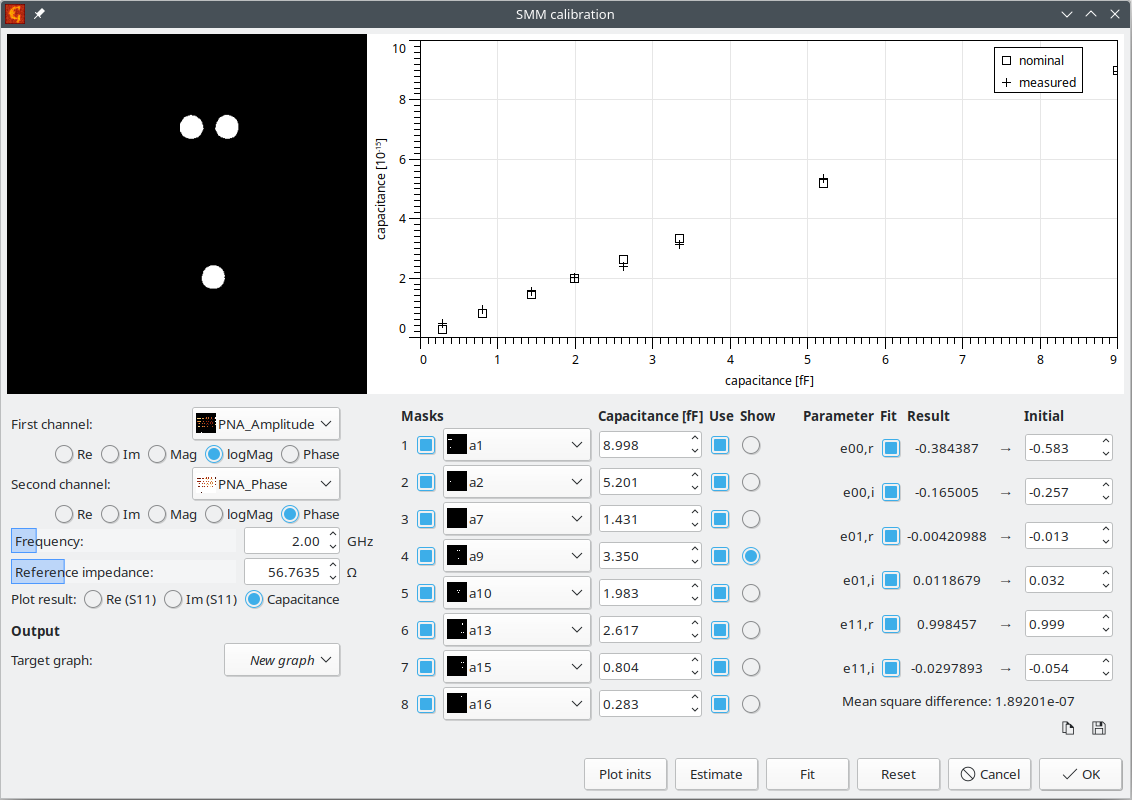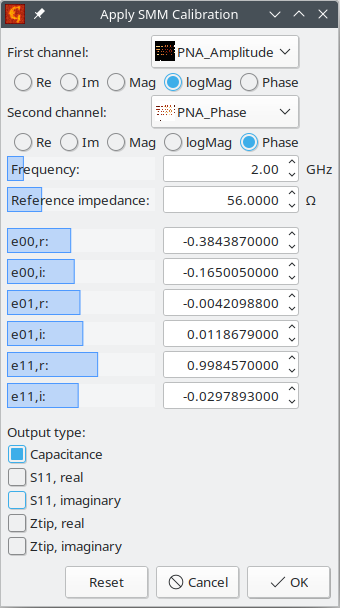Scanning Microwave Microscopy is based on measurement of reflection coefficients of microwaves applied to a conductive tip. Using vector network analyzer or similar hardware we want to obtain the reflection coefficient S11 and, out of it, to determine tip-sample impedance, capacitance, or any other quantity related to it.
Here, we describe two modules implementing modified short-open-load calibration procedure described in Ref. [1]. It is based on measurement of a sample with areas of known capacitances, e.g. small capacitors acting as reference samples[2], and by comparison of theoretical and measurement reflection coefficients it establishes complex calibration coefficients that can be used for SMM calibration, i.e. to convert measurement on unknown samples to quantitative results.
Goal of this module is to use data measured on a known sample to determine three complex calibration coefficients e00, e01 and e11 containing infomration about directivity, reflection tracking, source match, merged with information about the local electrical conditions around the tip apex[3]. The coefficients relate the measured reflection coefficients S11m to intrinstic reflection coefficients S11 as
The intrinstic reflection coefficients are related to complex tip-sample impedance Ztip and reference impedance Zref as
For a capacitor reference sample, the tip-sample impedance can be calculated from its known capacitance (obtained from sample manufacturer or via numerical modeling) and angular frequency of the microwaves as
The module uses the above three equations to determine the calibration coefficients, either by direct solution of the equations for three complex measurements (when only three sets are provided) or by fitting all the available data (when more sets are provided). Direct solution is also used for an estimate, using the minimum, maximum and middle of the provided capacitances.
Apart of two images representing complex data from VNA (either a pair of real + imaginary or module + phase images), user has to provide masks covering the individual surface areas where the capacitance is known and values of this capacitance. These masks have to be set up before running the module, either using thresholding or some of the mask edit tools, followed by mask extraction, so it resides in the Data Browser as an individual channel. User can check which of the provided sets (mask + capacitance) will be used for calculation or fitting of the calibration coefficients.
To test the module, use a sample file with pre-processed data, including with few extracted masks, corresponding to capacitances in the above figure. This sample file is based on measurements performed by Damien Richert, Laboratoire national de métrologie et d'essais and shows MC2 capacitance sample.
This module applies known complex calibration coefficients to the measured data, using the same methodology and equations as discussed in the preceding section. As an input, complex data from VNA (either a pair of real + imaginary or module + phase images) are used. When data should be converted to capacitance, the microwave frequency and reference impedance has to be supplied.
[1] Hoffmann, J.; Wollensack, M.; Zeier, M.; Niegemann, J.; Huber, H. A Calibration Algorithm for Nearfield Scanning Microwave Microscopes. In Proceedings of the 12th IEEE International Conference on Nanotechnology, IEEE-NANO, Birmingham, UK, 20–23 August 2012; pp. 1–4. doi:10.1109/NANO.2012.6322116
[2] Piquemal, F.; Morán-Meza, J.; Delvallée, A.; Richert, D.; Kaja, K., Progress in Traceable Nanoscale Capacitance Measurements Using Scanning Microwave Microscopy. Nanomaterials 2021, 11, 820. doi:10.3390/nano11030820
[3] A. Buchter, J. Hoffmann, A. Delvallée, E. Brinciotti, D. Hapiuk, Ch. Licitra, K. Louarn, A. Arnoult, G. Almuneau, F. Piquemal, M. Zeier, F. Kienberger, Review of Scientific Instruments 89, 023704 (2018). doi:10.1063/1.5015966

